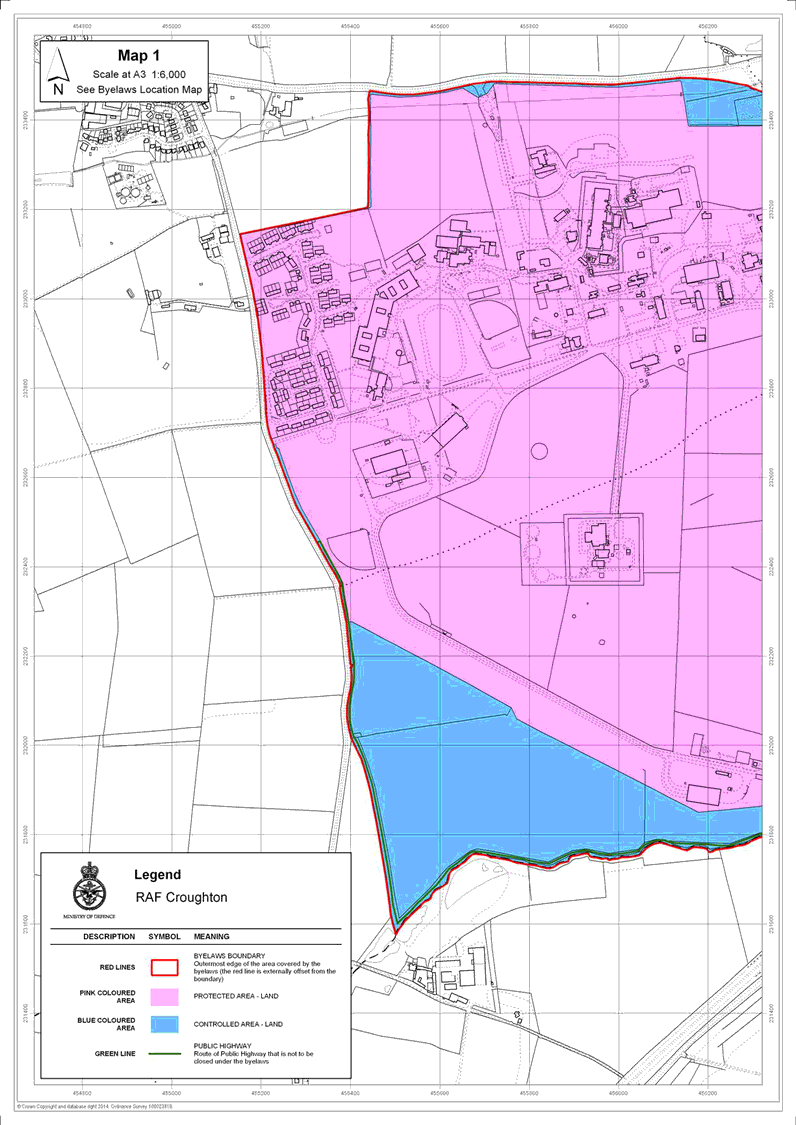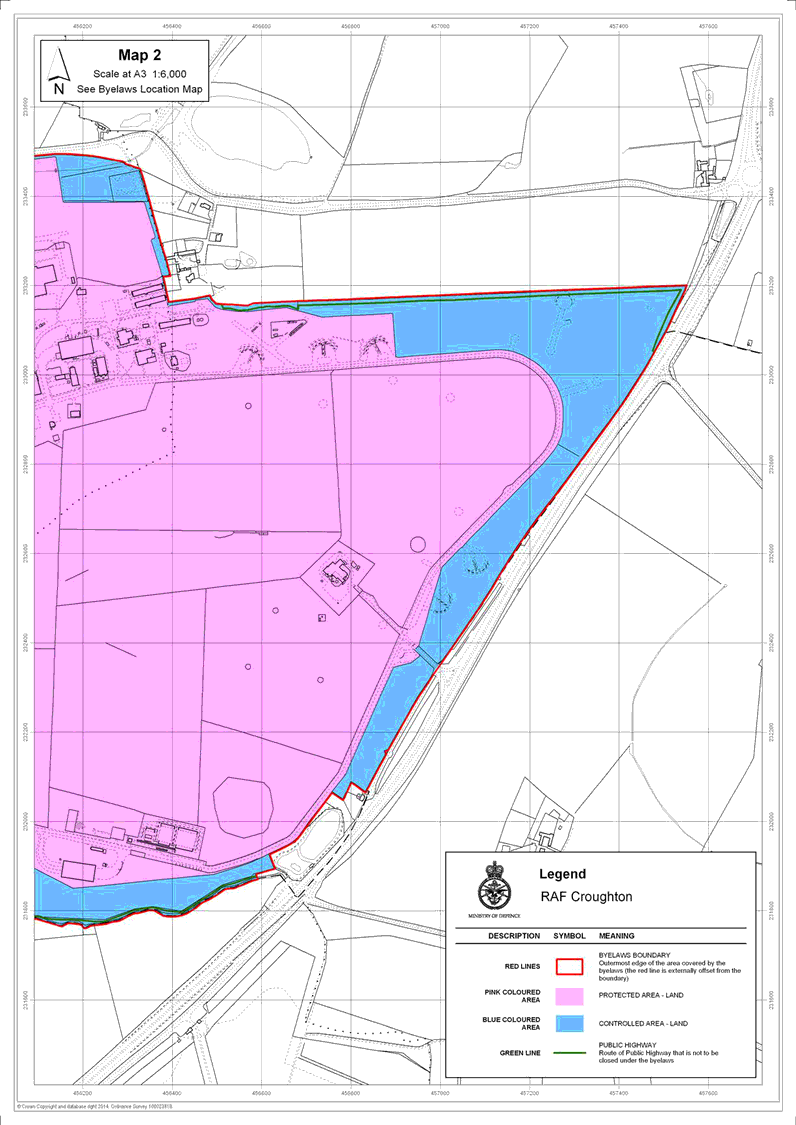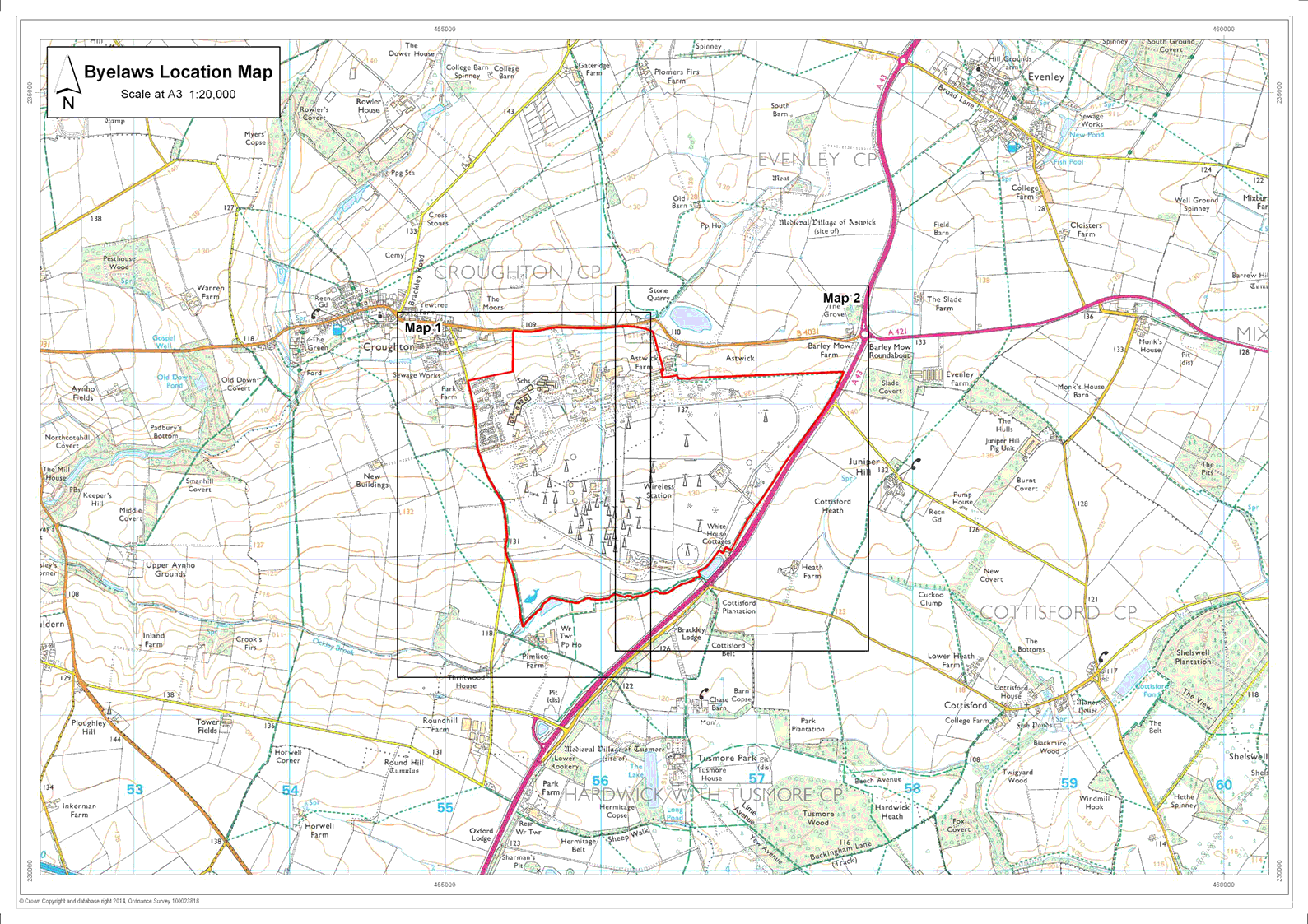2014 No. 855
The RAF Croughton Byelaws 2014
Made
Coming into force
The Secretary of State for Defence makes the following byelaws in exercise of the powers conferred by section 14(1) of the Military Lands Act 18921.
In accordance with section 17(1) of that Act the Secretary of State before making these byelaws caused the proposed byelaws to be made known in the locality, gave an opportunity for objections being made to the same, and received and considered all objections made.
Citation and commencement1
These byelaws may be cited as the RAF Croughton Byelaws 2014 and come into force on 19th July 2014.
Interpretation2
1
In these byelaws—
“appointed person” means the person who has been appointed by the Secretary of State for Defence to be responsible for the Protected Area and the Controlled Areas;
“Commonwealth force” has the same meaning as in section 374 of the Armed Forces Act 20062;
“Controlled Area” means an area of land coloured blue on the byelaws maps set out in the Schedule;
“firearm” has the same meaning as in section 57(1) of the Firearms Act 19683;
“headquarters” means a headquarters or organisation designated by an Order in Council under section 1 of the International Headquarters and Defence Organisations Act 19644;
“Her Majesty’s forces” has the same meaning as in section 374 of the Armed Forces Act 2006;
“invalid carriage” means an invalid carriage as defined in section 20 of the Chronically Sick and Disabled Persons Act 19705 that complies with the prescribed requirements and is used in accordance with the prescribed conditions set out in Regulations6 made by the Minster of Transport under section 20 of that Act;
“lawful user” means any—
- a
constable;
- b
member of Her Majesty’s forces;
- c
Crown servant;
- d
member of a Commonwealth force;
- e
member of a visiting force or headquarters; or
- f
person in possession of a written permission from the appointed person;
- a
“motor vehicle” does not include an invalid carriage;
“offensive weapon” has the meaning given in byelaw 3;
“Protected Area” means the area of land coloured pink on the byelaws maps set out in the Schedule;
“service authorities” means naval, military or air force authorities;
“short lead” means a lead of fixed length and of not more than two metres; and
“visiting force” means any body, contingent or detachment of the forces of a country for the time being present in the United Kingdom on the invitation of Her Majesty’s Government in the United Kingdom and any member of the civilian component of that force as defined in section 10 of the Visiting Forces Act 19527.
2
The Protected Area and the Controlled Areas together comprise an area of land known as RAF Croughton shown for illustrative purposes only on the location map set out in the Schedule.
Definition of offensive weapon3
For the purpose of these byelaws “offensive weapon” means any article—
a
made or adapted for use for causing injury to persons, animals or birds or for trapping animals or birds; or
b
intended by the person having it with him for such use or for threatening such use by him or by some other person.
Application of these byelaws4
1
Subject to paragraph (2), these byelaws apply to the Protected Area and the Controlled Areas.
2
These byelaws do not interfere with the highways within the Controlled Areas, and such highways are shown marked with a green line on the byelaws maps in the Schedule.
Prohibited Activities – Protected Area5
No person shall—
a
enter or leave the Protected Area except by way of an official entrance or exit;
b
remain in the Protected Area after having been directed to leave by a constable or person described in byelaw 12;
c
obstruct a lawful user acting in the proper exercise of their duty within the Protected Area;
d
cause or permit any vehicle, animal or thing to enter the Protected Area;
e
take any visual image of any person or thing within the Protected Area when they are in that area;
f
gain entry to the Protected Area as a result of making any false statement, either orally or in writing, or by employing any other form of misrepresentation;
g
board or interfere with the movement of any vehicle or aircraft within the Protected Area;
h
remove, interfere with, or obstruct the use of, any property within the Protected Area which is under the control of the Crown or the service authorities of either a visiting force or a headquarters, or the agents or contractors of the Crown or such service authorities;
i
deface any sign, wall, fence, structure or other surface within the Protected Area; or
j
fail to comply with any signs displayed within the Protected Area.
Use of the Controlled Areas by the Public6
1
Subject to the provisions of these byelaws, members of the public are permitted to enter and use all parts of the Controlled Areas not specifically enclosed or entry to which is not shown by signs or fences as being prohibited or restricted, for any lawful purpose at all times when the Controlled Areas are not being used for the military purposes for which they are appropriated.
2
When a Controlled Area is being used for military purposes it is closed to the public and entry to it is prohibited.
3
When a Controlled Area is being used for military purposes notice of the fact shall be given by placing a sign at each of the locations at which the highway enters that area.
4
Paragraph (1) does not apply to land used for residential purposes.
Prohibited Activities – Controlled Areas7
No person shall within a Controlled Area—
a
obstruct a lawful user acting in the proper exercise of their duty;
b
enter any part which is enclosed or entry to which is shown by a sign as being prohibited or restricted;
c
carry any firearm or offensive weapon;
d
remove, interfere with, or obstruct the use of, any property which is under the control of the Crown or the service authorities of either a visiting force or a headquarters, or the agents or contractors of the Crown or such service authorities;
e
drive a motor vehicle;
f
camp in tents, caravans, trees or otherwise;
g
cause any nuisance, or behave in an indecent or obscene manner;
h
deposit any industrial refuse, rubble, waste or litter or abandon any vehicle or vehicle part or any other article;
i
act in any way likely to cause annoyance, nuisance or injury to other person;
j
light fires or do anything likely to cause an outbreak of fire;
k
fail to keep under control any dog or other animal in their charge;
l
fail to keep any dog in their charge on a short lead during the period beginning with 1st March and ending with 31st July in each year;
m
fail to remove all waste created by any dog or other animal in their charge;
n
deface any sign, wall, fence, structure or other surface;
o
engage in any trade or business of any description or ride, drive, conduct or cause to be ridden, driven or conducted, use or employ any animal or vehicle or use any audible means either wholly or mainly for the purpose of trade or advertisement;
p
damage, cut or remove any crops, turfs, plants, roots or trees;
q
graze any animal;
r
kill or trap any birds or animals, or take or destroy their eggs;
s
dig or search for any item or interfere with or take any item found; or
t
fail to comply with any signs displayed within a Controlled Area.
Control of road traffic other than on the public highway8
1
Every person who rides a bicycle or drives a motor vehicle shall—
a
ride or drive on the road;
b
comply with any directions given by a constable or person described in byelaw 12;
c
comply with all traffic signs; and
d
ride or drive with due care and attention.
2
No person shall ride a bicycle or drive a motor vehicle on the road during the hours of darkness without using the appropriate lights.
3
No person shall—
a
drive any motor vehicle other than a site exempt vehicle without holding a valid driving licence; or
b
be in charge of any motor vehicle other than a site exempt vehicle unless that vehicle is insured for their use and is in a roadworthy condition.
4
No person shall stop or park any vehicle where “No Parking” or “No Waiting” notices are displayed, except for the purposes of loading or unloading passengers or goods.
5
For the purposes of this byelaw—
a
“appropriate lights” means the lamps required to be fitted and used when that motor vehicle or pedal cycle is used on a public highway during the hours of darkness in accordance with the Road Vehicles Lighting Regulations 19898;
b
“hours of darkness” means the time between half an hour after sunset and half an hour before sunrise;
c
“site exempt vehicle” means any motor vehicle used by a lawful user with permission from the appointed person.
Direction to leave etc9
1
In order to—
a
prevent the breach of any provision of byelaw 5, 6, 7 or 8; or
b
prevent any nuisance, disorder, obstruction or damage to the land or any property within the Protected Area and the Controlled Areas,
a constable or person described in byelaw 12 may direct any person to leave or to remove any vehicle, animal or thing over which they have control from the Protected Area and the Controlled Areas.
2
Any person to whom a direction is given under paragraph (1) shall comply with it as soon as practicable.
Exemptions10
Byelaws 5, 6, 7 and 8 shall not apply to anything done—
a
by a lawful user in connection with the discharge of their functions; or
b
by a person acting under and in accordance with any permission given in writing by the appointed person.
Offences11
1
Subject to paragraph (2), any person who contravenes byelaw 5, 6, 7, 8 or 9 commits an offence.
2
No offence is committed where a person has a reasonable excuse for contravening paragraph (k), (l) or (m) of byelaw 7.
Enforcement12
The following persons are authorised to remove from the Protected Area and the Controlled Areas and to take into custody without warrant any person committing an offence against these byelaws and to remove from those Areas any vehicle, animal or thing found there in contravention of these byelaws—
a
the appointed person;
b
any officer, warrant officer or non–commissioned officer in uniform and acting under the instructions of the appointed person; and
c
any Crown servant authorised in writing by the appointed person.
Signed on behalf of the Secretary of State for Defence
SCHEDULEByelaws maps
(This note is not part of the Byelaws)


